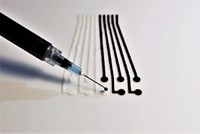Advertisement
Grab your lab coat. Let's get started
Welcome!
Welcome!
Create an account below to get 6 C&EN articles per month, receive newsletters and more - all free.
It seems this is your first time logging in online. Please enter the following information to continue.
As an ACS member you automatically get access to this site. All we need is few more details to create your reading experience.
Not you? Sign in with a different account.
Not you? Sign in with a different account.
ERROR 1
ERROR 1
ERROR 2
ERROR 2
ERROR 2
ERROR 2
ERROR 2
Password and Confirm password must match.
If you have an ACS member number, please enter it here so we can link this account to your membership. (optional)
ERROR 2
ACS values your privacy. By submitting your information, you are gaining access to C&EN and subscribing to our weekly newsletter. We use the information you provide to make your reading experience better, and we will never sell your data to third party members.
Materials
Nanocube-Nanotube Biosensors
Hybrid structure leads to sensitive detectors with wide linear response
by Mitch Jacoby
February 2, 2009
| A version of this story appeared in
Volume 87, Issue 5

Networks of single-walled carbon nanotubes decorated with metallic nanocubes can serve as highly sensitive detectors for measuring biomolecules over a wide range of concentrations, according to a new study in ACS Nano (DOI: 10.1021/nn800682m). Purdue University engineers Timothy S. Fisher, D. Marshall Porterfield, and coworkers capitalized on a technique they developed previously for growing nanotubes vertically on top of a silicon wafer by augmenting the nanotubes with gold-coated palladium nanocubes. The nanocubes, which grow via electrodeposition and are tethered to the nanotubes, serve as docking points for attaching biomolecules and as electrocatalysts that facilitate the detection process. Testing the devices' performance as electrochemical sensors for glucose, the Purdue team attached glucose oxidase to the nanocubes via thiol linkages and found that the sensors exhibit a detection limit of about 1 µM and a linear response between 10 µM and 50 mM. Those values represent a performance enhancement of roughly a factor of five compared with other glucose sensors based on carbon nanotubes and metallic nanoparticles and nanowires, the team says.





Join the conversation
Contact the reporter
Submit a Letter to the Editor for publication
Engage with us on Twitter